Nutrition in Plants
NCERT Class 7 Science Chapter-1-Notes,Solutions,Video,Tests, PDF
Theory
Topics to be learn :
- Mode of nutrition in plants
- Photosynthesis — food making process in plants
- Synthesis of plant food other than carbohydrates
- Other modes of nutrition in plants
[responsivevoice voice="UK English Female" rate="0.8" pitch="0.8" buttontext="Listen to this"]
1 Nutrition :
(1) Nutrition : The process of ingesting and using food for energy in living organisms is called a process of nutrition.
(2) Food stuffs: Foodstuffs are the substances which are ingested, digested and assimilated to give energy, help in growth and building health of our body
(3) Nutrients- Certain substances are present in the foods that help in the survival of the organisms. These special substances are called nutrients for example, proteins, vitamins, carbohydrates, minerals and fats.
Some living organisms like plants synthesize their food by themselves while others such as animals depend upon the plants and other animals for their food.

(4) Need for nutrition :
(a) Supply of energy. Growth and development.
(b) Replacing the damaged cells and repairing worn out tissues.
(c) To fight diseases.
Based on the mode of nutrition organisms can be divided into two categories:
(I) Autotrophic nutrition : Some organisms like plants can prepare their own food for nourishment. This mode is called autotrophic nutrition.
(II) Heterotrophic nutrition : Some organisms like animals depend on other plants or animals, for their food. This is called heterotrophic nutrition. [/responsivevoice]
[responsivevoice voice="UK English Female" rate="0.8" pitch="0.8" buttontext="Listen to this"]
How do plants prepare their food?
Plants prepare their food with the help of certain raw materials that they gather from their surroundings:
- Water, carbon dioxide, sunlight, minerals, chlorophyll
The process by which plants prepare their food by using these raw materials is called Photosynthesis.
.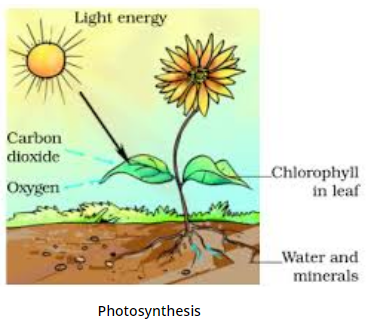
Photosynthesis :
(i) Photosynthesis is the process performed by the plants with the help of sunlight and chlorophyll by using water and nutrients from the soil and carbon dioxide from the air, in which own food is synthesized.
(ii) Chemical equations for photosynthesis.

Where is the food made in plants?
(i) Energy is transformed in process of photosynthesis. Light energy of sun is converted into chemical energy which is stored in the form of food.
(ii) Roots absorb water, minerals and salts from the soil. Stem transports these materials up to the leaves. Carbon dioxide from the air is taken inside from the stomata on the leaves.
(iii) In the leaves there are chloroplasts which contain chlorophyll, which absorbs sunlight, and helps in the conversion of carbon dioxide and water into food.
(iv) In the process of photosynthesis oxygen is given out.
(v) The green parts of the plants that have chlorophyll perform photosynthesis.
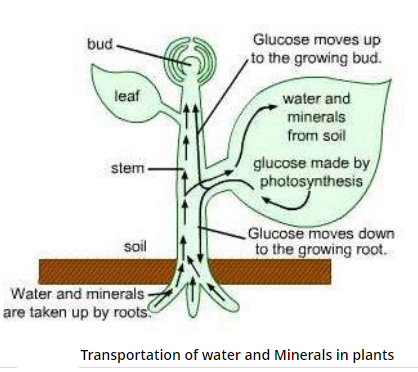
- Inhalation of Carbon Dioxide- There are tiny holes or pores present on the surface of the leaves called Stomata that take in the carbon dioxide present in the atmosphere.
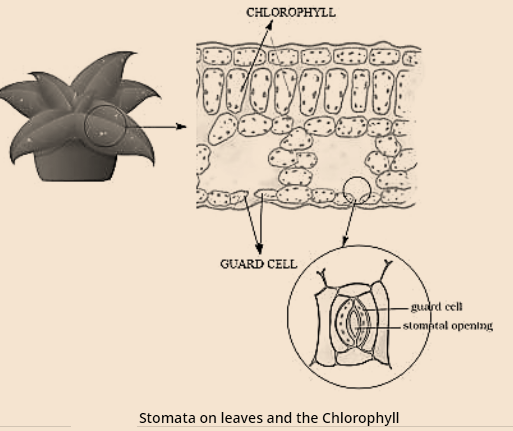
- Presences of Chlorophyll in the Leaves- A substance called Chlorophyll is present in the leaves of the plants. It is a green colour pigment. The chlorophyll not only provides green colour to the leaves but also helps in the process of photosynthesis. Chlorophyll captures the sunlight and along with other raw materials prepares the food in the leaves.
- This process of photosynthesis only occurs in the daytime in the presence of Sunlight hence it is called Photosynthesis, photo means light.
Why sun is called the ultimate source of energy for all living organisms?
We know that the plants use solar energy to make their food. The herbivores animals depend upon the plants for their food. Animals (carnivores) that do not eat plants depend upon the herbivores animals. Therefore, all of the living organisms directly or indirectly receive their energy from the Sun. [/responsivevoice]
[responsivevoice voice="UK English Female" rate="0.8" pitch="0.8" buttontext="Listen to this"]
All living organisms are made up of tiny structures called cells. Some organisms (microscopic) contains only one cell while others plants and animals contain many cells of different kinds.
Parts of a cell:
- The Nucleus- Every cell has a nucleus present in the centre that performs various functions of the cell.
- The Cell Membrane- Every cell has an outer boundary which protects the cell called the Cell Membrane.
- The cytoplasm- Every cell has a gel-like structure present in it called the Cytoplasm.
- Cell organelles:These are membrane bound structures found within a cell in the cytoplasm. The cell organelles have special function associated with them. Different cell organelles found in the cell are:
- Mitochondria – Produces energy for the cell
- Endoplasmic Reticulum– Produces lipids and proteins in cell
- Golgi apparatus– Helps in exporting materials out of cell
- Lysosomes– Help in digestion in the cell
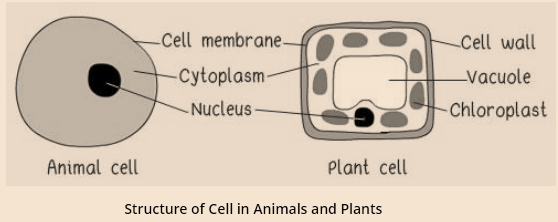
Can photosynthesis take place in other parts of the plant?
Yes, green stems and branches of the plants can also undergo the process of photosynthesis. For example, plants in the desert area like cactus do not have leaves but they still exist there because their stem produces the food for the plant.
Why is the process of photosynthesis important?
- There will be no food if the plants would stop conducting the photosynthesis process.
- The plants take in carbon dioxide and produce oxygen during the process of photosynthesis. Hence, without this process, it would not be possible to survive on earth as they would be no oxygen.
Production of Oxygen and Carbohydrates by the Plants
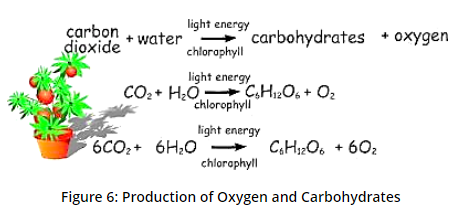
Plants use carbon dioxide and water in presence of the sunlight and chlorophyll to produce carbohydrates and oxygen. The carbohydrates thus produced by the plants are converted into starch.
Chloroplast and the Process of Photosynthesis
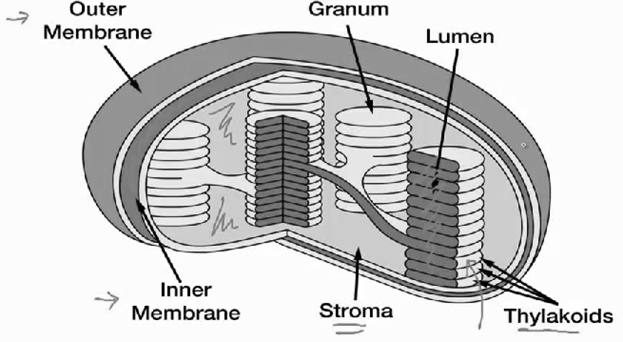
- Chloroplasts are special cell organelles that are found only in plant cells. They are called the food producers of the plant cells.
- The chloroplasts are surrounded by two membranes called the Inner and Outer Membrane. The inner membrane surrounds stroma and thylakoid
- The chlorophyll molecules are present on each of the thylakoids. The chloroplasts convert the sunlight into sugars that are used by the plant cells.
- Hence, chloroplasts allow the conduction of the process of photosynthesis. The chlorophyllthat can absorb the sunlight is present inside the chloroplasts.
- When the light of the sun hits the chloroplasts and the chlorophyll, the light energy is converted into chemical energy found in compounds such as ATP and NADPH.
- Then these energy molecules move into the stroma where carbon dioxide is attached to them. As a result of the molecular reactions, oxygen and glucose are created.
Can leaves which are red or Brown or violet in colour conduct photosynthesis?
Yes, the chlorophyll is also present in leaves that are not green in color. They are of different colours because the other colour pigments are more than the green colour pigments in such leaves.
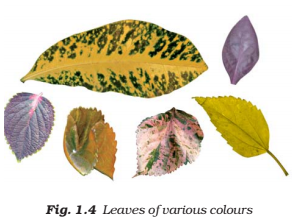
Algae contain chlorophyll ?
Algae are green coloured organisms found in the stagnant water. They get their green color from chlorophyll. Since they have chlorophyll in them they are capable of conducting photosynthesis.
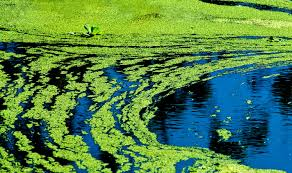
Algae
How do plants generate proteins and fats?
- Along with carbohydrates, plants can also produce proteins and fats which are formed with the help of Nitrogen.
- Nitrogen is present in large amounts in the air but plants cannot consume the nitrogen directly from the atmosphere.
- The soil often contains some bacteria that are capable of converting the nitrogen into nitrates which can be the used by the plants.
- Also, fertilizers used by farmers and gardeners contain a high amount of Nitrogen which mixes into the soil and is used by the plants. [/responsivevoice]
[responsivevoice voice="UK English Female" rate="0.8" pitch="0.8" buttontext="Listen to this"]
Many plants do not contain any chlorophyll. Hence they are unable to prepare their food by themselves. Therefore, they rely on other plants and animals for their food.
- Parasitic Plants- Some plants live on another plant for their nutrition. These are called parasites. The plants on which these parasitic plants survive are called the host. For Example, cuscuta is a parasitic plant.
- Insectivorous Plants- Some plants depend upon insects for the food and thus are called Insectivorous. The leaves of these plants are modified into a pitcher like structure. The top part of the leaves acts as a lid which can open and close the pitcher. The pitcher contains hair in a downward direction which traps the insects. The pitcher on capturing the insect secretes some digestive juices which help in the digestion of the insect. For Example, Dischidia and Nepenthes
- Saprotrophs- Some organisms survive on decaying food and organisms. This mode of nutrition is called saprotrophic nutrition and the organisms that survive because of the saprotrophic nutrition are called Saprophytes.
How do saprophytes obtain their nutrition?
- The saprophytes secrete digestive juices on the decaying and dead matter.
- These juices convert the matter into a solution.
- The saprophytes that absorb the nutrients from the solution.
- For Example, Fungi (yeast and mushrooms) are a saprophytes that can be found on stale food and pickles which are exposed to the hot and humid environment.

Symbiotic Relationship - Sometimes organisms live together to share shelter and food with each other. These are said to have a symbiotic relationship.
Examples of organisms living in a symbiotic relationship:
- Some fungi live in the roots of the trees. These fungi take food from the trees and in return help the trees in absorbing water and nutrients from the soil.
- Sometimes an organism that contains chlorophyll such as algae lives in association with a fungus (together called as Lichens). The algae provide food and nutrition to the fungus while the fungus provides water, minerals and shelter to the algae. [/responsivevoice]
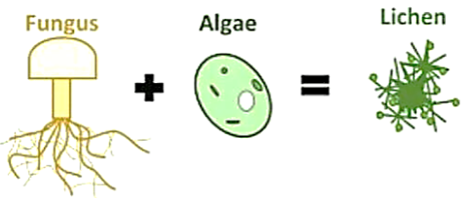
[responsivevoice voice="UK English Female" rate="0.8" pitch="0.8" buttontext="Listen to this"]
Replenishing the Soil with Nutrients
- Plants get their nutrients from the soil mainly hence there is a need to replenish the soil again with nutrients so that the plants can survive on it.
- Fertilizers and manure are often used to replenish the soil with the nutrients. They contain potassium, phosphorus and nitrogen all of which are important for the plants.
- A bacterium called Rhizobiumis present in the soil which can convert nitrogen present in it in the form that can be consumed by the plants.
The rhizobium generally lives in the roots of the plants such as peas, beans, grams and legumes and provides nitrogen to these plants. This again is an example of a symbiotic relationship. The farmers often do not need to use fertilizers while growing such crops. [/responsivevoice]
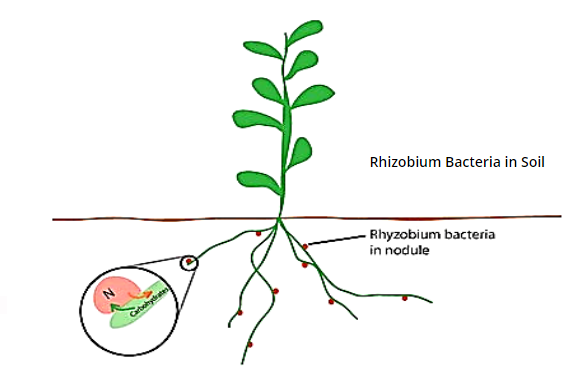
[responsivevoice voice="UK English Female" rate="0.8" pitch="0.8" buttontext="Listen to this"]
Quick Revision
- Living organisms such as plants and animals survive on food.
- The food gives them the energy to perform several activities in their life and helps in the growth.
- All organisms take food and utilise it to get energy for the growth and maintenance of their bodies.
- Green plants synthesise their food themselves by the process of photosynthesis. They are autotrophs.
- Plants use simple chemical substances like carbon dioxide, water and minerals for the synthesis of food.
- Chlorophyll and sunlight are the essential requirements for photosynthesis.
- Complex chemical substances such as carbohydrates are the products of photosynthesis.
- Solar energy is stored in the form of food in the leaves with the help of chlorophyll.
- Oxygen is produced during photosynthesis.
- Oxygen released in photosynthesis is utilised by living organisms for their survival.
- Fungi derive nutrition from dead, decaying matter. They are saprotrophs.
- Plants like Cuscuta are parasites. They take food from the host plant.
- A few plants and all animals are dependent on others for their nutrition and are called heterotrophs. [/responsivevoice]
NCERT Class-7-Science-Chapter-1-Nutrition in Plants-Solution
Question 1:
Why do organisms need to take food?
Question 2:
Distinguish between a parasite and saprophyte.
Parasite
Saprotroph
The organism that grows on the body of another organism and derives nutrients from it is known as a parasite.
The organism that obtains nutrients from the dead or decaying organic matter is called saprotroph.
Examples of parasites are Cuscuta and orchids.
Examples of saprotrophs are fungi and some bacteria.
Question 3:
How would you test the presence of starch in leaves?
When starch comes in contact with iodine solution, gives a characteristic dark blue color. So, when we add a few drops of iodine solution on leaf and if the dark blue color appears, that will confirm the presence of starch in leaves.
Question 4:
Give the brief description of the process of synthesis of food in green plants.
Photosynthesis is defined as the process in which the chlorophyll-containing plant cells synthesise food in the form of carbohydrates, using carbon dioxide and water in the presence of solar energy. Photosynthesis Sources of raw materials required for photosynthesis: (a) Water is taken in from the roots of the plant and is transported to the leaves. (b) Carbon dioxide from the air enters the leaves through the tiny pores called stomata and diffuses to the cells containing chlorophyll. (c) Solar energy is used to break water into hydrogen and oxygen. This hydrogen is combined with carbon dioxide to form food for the plants, which is ultimately used by the animals as well. Thus, photosynthesis can be represented by the following equation. During this process oxygen is liberated and the formed carbohydrates is stored in the form of starch.
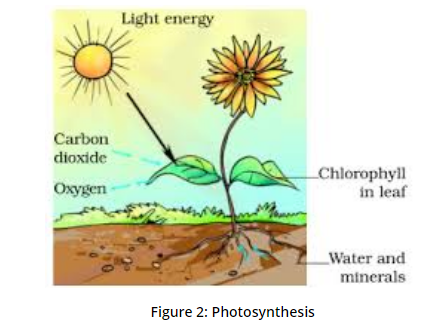
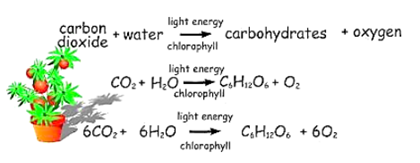
Question 5:
Show with the help of a sketch that the plants are ultimate source of food.
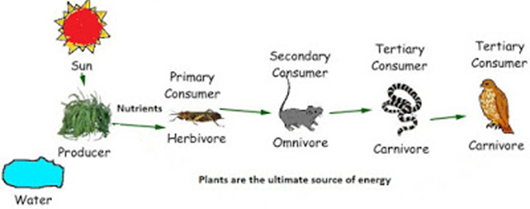
Question 6:
Fill in the blanks:
(a) Green plants are called ----------- since they synthesize their own food.
(b) The food synthesized by the plants is stored as ---------------.
(c) In photosynthesis solar energy is captured by the pigment called --------
(d) During photosynthesis plants take in ------------- and release -------------
Question 7:
Name the following:
(a) A parasitic plant with yellow, slender and tubular stem.
(b) A plant that has both autotrophic and heterotrophic mode of
(c) The pores through which leaves exchange gases.
(i) Cuscuta (ii) Pitcher plant (iii) Stomata
Question 8:
Tick the correct answer:
(a) Cuscuta is an example of:
(i) autotroph (ii) parasite (iii) saprotroph (iv) host
(a) Cuscuta is an example of: (ii) parasite √
(b) The plant which traps and feeds on insects is:
(i) Cuscuta (ii) china rose (iii) pitcher plant (iv) rose
(b) The plant which traps and feeds on insects is: (iii) Pitcher plant √
Question 9:
Match the item in given column I with those in column II.
| Column I | Column II |
| Chlorophyll | Rhizobium |
| Nitrogen | Heterotrophs |
| Cuscuta | Pitcher plant |
| Animals | Leaf |
| Insects | Parasite |
Column I
Column II
Chlorophyll
Leaf
Nitrogen
Rhizobium
Cuscuta
Parasite
Animals
Heterotrophs
Insects
Pitcher plant
Question 10:
Mark “T” if the statement is true and “F” if it is false:
(i) Carbon dioxide is released during photosynthesis. (T/F)
(ii) Plant which synthesis their food themselves are called saprotrophs. (T/F)
(iii) The product of photosynthesis is not a protein. (T/F)
(iv) Solar energy is converted into chemical energy during photosynthesis. (T/F)
(i) Carbon dioxide is released during photosynthesis. (F) (ii) Plants which synthesise their food are called saprotrophs. (F) (iii) The product of photosynthesis is not a protein. (T) (iv) Solar energy is converted into chemical energy during photosynthesis. (T)
Question 11:
Choose the correct option from the following:
Which part of plant gets carbon dioxide from the air for photosynthesis?
- (a) Root hair
- (b) Stomata
- (c) Leaf veins
- (d) Sepals
(ii) Stomata
Question 12:
Choose the correct option from the following:
Plants take carbon dioxide from the atmosphere mainly through their:
- (a) Roots
- (b) Stem
- (c) Flowers
- (d) Leaves
(iv) leaves
Question 13:
Why do farmers grow many fruits and vegetable crops inside large green houses? What are the advantages to the farmers?
Green houses allow farmers to regulate the climate and other conditions for the proper growth of crops. Growing fruits and vegetables in large green houses provide following advantages to the farmers: 1.It allows them to provide optimum temperature to plants.
2.It helps in the protection of plants from rodents.
Video
Click on below link to open video
1- [video_lightbox_youtube video_id="Vj_78w92JfY&rel=0" width="640" height="520" start="10" anchor="Introduction"]
2- [video_lightbox_youtube video_id="EXIDajagxDs&rel=0" width="640" height="520" start="10" anchor="Cells in Living Organism"]
3- [video_lightbox_youtube video_id="-QXsCyEZ4T8&rel=0" width="640" height="520" start="10" anchor="How Nutrients Are Replenished In The Soil?"]
4- [video_lightbox_youtube video_id="BNaAmi4_8Dc&rel=0" width="640" height="520" start="10" anchor="Mode of Nutrition in Plants"]
5- [video_lightbox_youtube video_id="R60bpHM4FR8&rel=0" width="640" height="520" start="10" anchor="Mode of Nutrition in Plants (Part 2)"]
6- [video_lightbox_youtube video_id="FYnA52BSfLQ&rel=0" width="640" height="520" start="10" anchor="How Do Plants Prepare Their Food?"]
7- [video_lightbox_youtube video_id="F9qUsJJQCUU&rel=0" width="640" height="520" start="10" anchor="Q1 & Q2 : Nutrition in Plants"]
8- [video_lightbox_youtube video_id="ey83hHTEMT4&rel=0" width="640" height="520" start="10" anchor="Q3 & Q4 : Nutrition in Plants"]
9- [video_lightbox_youtube video_id="JLa9S_V2eSE&rel=0" width="640" height="520" start="10" anchor="Q 6 & Q 7 : Chapter 1"]
10- [video_lightbox_youtube video_id="uBEBYEEk2Hk&rel=0" width="640" height="520" start="10" anchor="Q 8 & Q 9 : Chapter 1"]
11- [video_lightbox_youtube video_id="CjlEKtUnCx8&rel=0" width="640" height="520" start="10" anchor="Q 10, Q11 & Q 12 : Chapter 1"]
Click on below link to View and Download
NCERT- Class 7-Science Chapter 1 Notes PDF